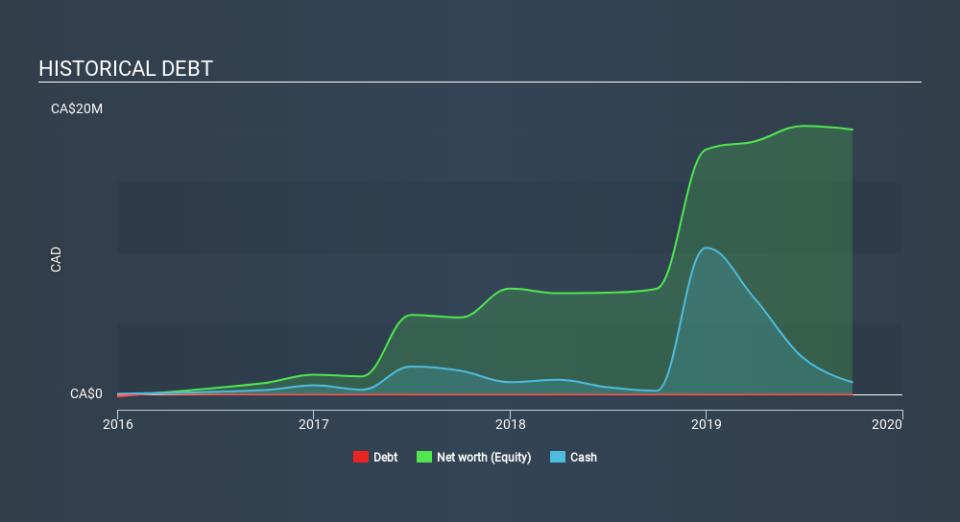Can Pulse Oil (CVE:PUL) Fund Its Growth Plans?

There's no doubt that money can be made by owning shares of unprofitable businesses. For example, although Amazon.com made losses for many years after listing, if you had bought and held the shares since 1999, you would have made a fortune. Having said that, unprofitable companies are risky because they could potentially burn through all their cash and become distressed.
So should Pulse Oil (CVE:PUL) shareholders be worried about its cash burn? For the purposes of this article, cash burn is the annual rate at which an unprofitable company spends cash to fund its growth; its negative free cash flow. We'll start by comparing its cash burn with its cash reserves in order to calculate its cash runway.
View our latest analysis for Pulse Oil
How Long Is Pulse Oil's Cash Runway?
A company's cash runway is the amount of time it would take to burn through its cash reserves at its current cash burn rate. As at September 2019, Pulse Oil had cash of CA$866k and no debt. Importantly, its cash burn was CA$11m over the trailing twelve months. That means it had a cash runway of under two months as of September 2019. To be frank we are alarmed by how short that cash runway is! You can see how its cash balance has changed over time in the image below.
How Well Is Pulse Oil Growing?
It was quite stunning to see that Pulse Oil increased its cash burn by 754% over the last year. As if that's not bad enough, the operating revenue also dropped by 16%, making us very wary indeed. In light of the above-mentioned, we're pretty wary of the trajectory the company seems to be on. In reality, this article only makes a short study of the company's growth data. You can take a look at how Pulse Oil has developed its business over time by checking this visualization of its revenue and earnings history.
How Hard Would It Be For Pulse Oil To Raise More Cash For Growth?
Given its revenue and free cash flow are both moving in the wrong direction, shareholders may well be wondering how easily Pulse Oil could raise cash. Companies can raise capital through either debt or equity. One of the main advantages held by publicly listed companies is that they can sell shares to investors to raise cash to fund growth. By comparing a company's annual cash burn to its total market capitalisation, we can estimate roughly how many shares it would have to issue in order to run the company for another year (at the same burn rate).
Since it has a market capitalisation of CA$6.1m, Pulse Oil's CA$11m in cash burn equates to about 174% of its market value. That suggests the company may have some funding difficulties, and we'd be very wary of the stock.
So, Should We Worry About Pulse Oil's Cash Burn?
As you can probably tell by now, we're rather concerned about Pulse Oil's cash burn. In particular, we think its cash runway suggests it isn't in a good position to keep funding growth. While not as bad as its cash runway, its falling revenue is also a concern, and considering everything mentioned above, we're struggling to find much to be optimistic about. Its cash burn situation feels about as comfortable as sitting next to the lavatory on a long haul flight. It's likely to need more cash in the near term; and that could well hurt returns. While we always like to monitor cash burn for early stage companies, qualitative factors such as the CEO pay can also shed light on the situation. Click here to see free what the Pulse Oil CEO is paid..
If you would prefer to check out another company with better fundamentals, then do not miss this free list of interesting companies, that have HIGH return on equity and low debt or this list of stocks which are all forecast to grow.
If you spot an error that warrants correction, please contact the editor at editorial-team@simplywallst.com. This article by Simply Wall St is general in nature. It does not constitute a recommendation to buy or sell any stock, and does not take account of your objectives, or your financial situation. Simply Wall St has no position in the stocks mentioned.
We aim to bring you long-term focused research analysis driven by fundamental data. Note that our analysis may not factor in the latest price-sensitive company announcements or qualitative material. Thank you for reading.

 Yahoo Finance
Yahoo Finance 
